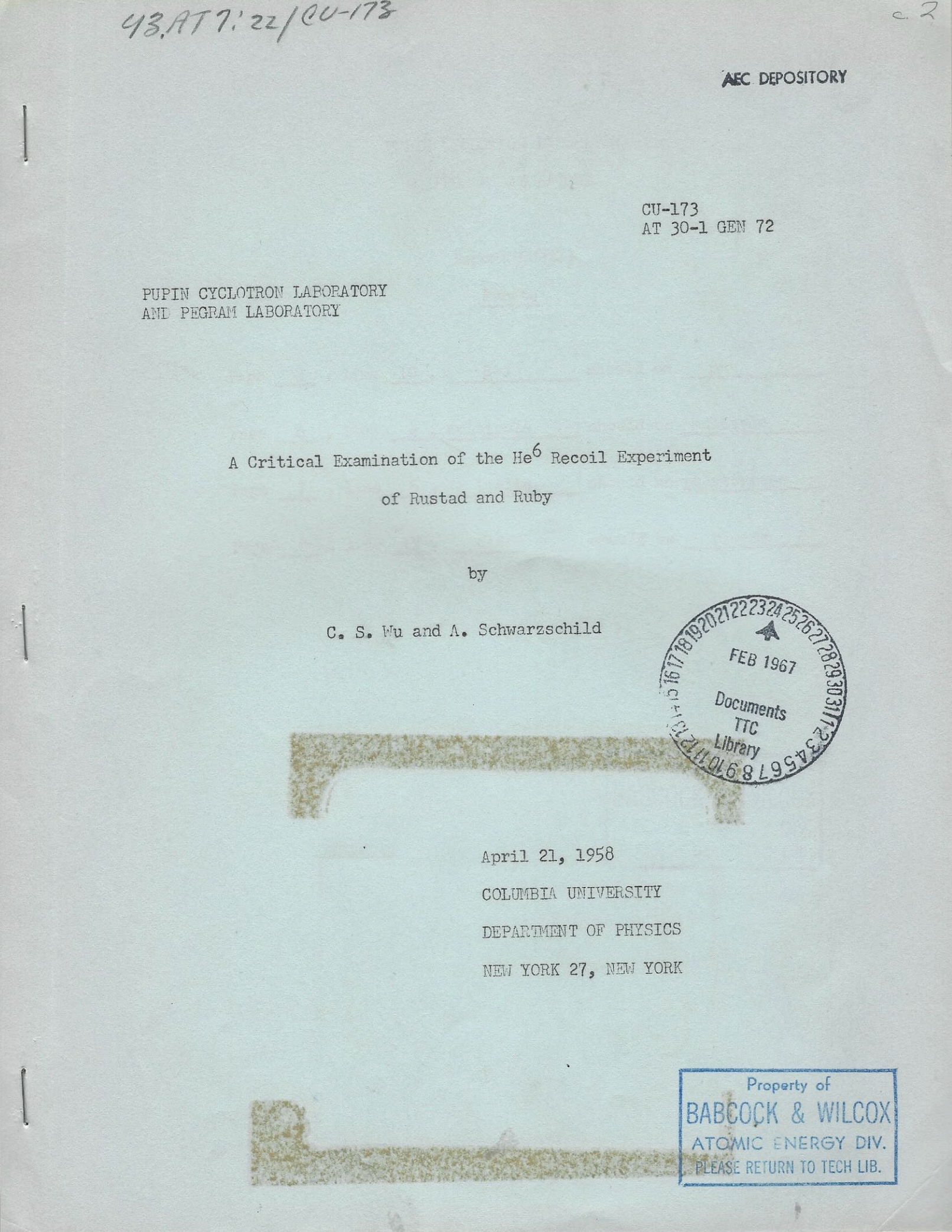My reasons for posting CU-173, the Wu-Schwarzchild report, as a public download
Publication of scientific results is integral to the scientific process. Open sharing of the details of new researches and developments within the scientific community, usually in the form of publications in scientific journals, is a main mechanism for the advancement of scientific knowledge. Most important, open publication allows other scientists to respond to prior scientific work, either to confirm, build on, or contradict an earlier result.
This is how science advances. New theories and experimental techniques are tried out in the marketplace of ideas. They stand or fall on their merit and usefulness to other scientists.
Chien-Shiung Wu was a master of scientific publication who produced hundreds of journal articles, monographs, lectures, chapters, textbooks and more during her stellar career. Yet, when she conducted her "Critical Examination of the He6 Recoil Experiment of Rustad and Ruby" together with Arthur Schwarzchild, she did not openly publish the results of the study in a publicly circulated physics journal.
Instead, the 18-page paper was filed as an internal Columbia University "technical report" on April 21, 1958, where it was doubtlessly carefully read by Wu's colleagues in the physics department. Printed copies bound in a green cover were then distributed to a selected list of recipients, including specific scientists working in the field and to libraries at major nuclear laboratories.
It was cited in a journal articles by various physicists in the following years. I learned of it in 2012 when discovering the history of the Rustad-Ruby experiment by reading Allan Franklin's scholarly writings about experimental error. Evidently, even Franklin had trouble laying hands on a copy; in one of his papers, he thanks a British physicist, B.W. Ridley, for lending him a copy.
In 2016, I made a trip to New York to research in the C.S. Wu Papers in the Columbia University Special Collections. The main purpose for the trip was hopefully to find a copy of the report in her files. I spent two days inspecting boxes of her records, most of which were from after 1960. The best part was reading her correspondence with world-famous physicists.
But, alas, the Critical Examination paper was not there, nor any files I could find specific to the Rustad-Ruby business. I did have one other payoff on that trip that I won't go into now (but will come back to). But I had come up empty handed in my search for CU-173.
However, when I got home and undertook a more comprehensive search, I noticed there was a single WorldCat listing for it—a hard copy of the report held at the Texas Tech University Library. I'm not sure how I missed that before, but now I made arrangements with a friend in academia to request an interlibrary loan, and a few weeks later I held it in my hands.
It was a copy that had been sent in June 1958 to the technical library of the Babcock & Wilcox Atomic Energy Division in Lynchburg, Va, then accessioned to the Texas Tech library in February 1967. I'm not sure how many people before me had ever checked it out.
I had the paper scanned to a PDF before returning it through the UCLA library. Unfortunately, the scan is not perfect and there is blurring along the document eft margin. I have had access to the document for the last five years and have reviewed it several times. I apologize, however, I never wrote about it for the blog until now.
I wasn't ready at the time to dig into the complicated science involved either in this paper or the overall field of nuclear physics. Now, belatedly, all that work is happening.
The main way I have been educating myself is by assembling and cataloging a library of source documents relevant to the Rustad-Ruby experiment. I'll write more about the citation library at another time, but here I want to mention that I am careful in presenting these sources not to infringe on publisher copyrights. FHM citations include an abstract or summary as well as selected excerpts, but the full text of source documents are not readable or downloadable on the site.
There are a handful of citations that come with an option to download a PDF. I'll use this sparingly when a document is clearly in the public domain, or when I have explicit permission. I mention all this here as a preamble for my explanation about why I decided to post my PDF of the Texas Tech's copy of the CU-173 document.
1. The document is of academic interest to science historians.
2. It is not available elsewhere in an electronic format.
3. It has been 64 years since the date of publication.
4. There is no good reason for it to be secret.
5. My father's reputation and memory are affected by the report's content.
6. C.S. Wu is a prominent historical figure, more so today than at the time of her death in 1997.
I believe all of these add up to an argument for fair use and a justification for my decision to post the paper publicly. If anyone at Columbia or Texas Tech disagrees, feel free to contact me.
Click the link to the right under Download Vault to view the document or download it to your computer. Also, you may view the FHM citation for it as an introduction to our citation feature.
I am not going to get into the substance of the report today. There will be multiple posts coming up on that and related matters. For now, you can take a first look at the document. Pay attention to the first few pages, the conclusion and also the acknowledgements.

